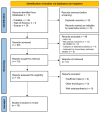Complications in Distal Minimally Invasive Metatarsal Osteotomies: Systematic Review and Meta-Analysis
- PMID: 40870480
- PMCID: PMC12388041
- DOI: 10.3390/medicina61081435
Complications in Distal Minimally Invasive Metatarsal Osteotomies: Systematic Review and Meta-Analysis
Abstract
Background and Objectives: Minimally invasive distal metatarsal osteotomy (DMMO) has established itself as an effective surgical technique for the treatment of metatarsalgia, notable for its reduced postoperative pain and faster recovery. However, doubts remain regarding the frequency and nature of postoperative complications. The objective of this systematic review and meta-analysis was to evaluate the incidence of the most frequent complications associated with the DMMO technique, including prolonged edema, delayed bone healing, transfer metatarsalgia, floating toe, and persistent pain. Materials and Methods: A systematic review was conducted following the PRISMA 2020 guidelines, with the protocol registered in the PROSPERO database (CRD420251067666). Searches were conducted in the PubMed, Scopus, and Web of Science databases, including clinical studies published between 2010 and 2025. The inclusion criteria covered studies in adults treated with DMMO and reporting postoperative complications. The methodological quality assessment was performed using Joanna Briggs Institute (JBI) tools according to the design of each study. Random-effects models were used for the meta-analyses, assessing heterogeneity using the I2 statistic. Results: Fifteen studies with a total sample of more than 493 patients were included. Prolonged edema was the most common complication (30.91%), followed by delayed bone healing (14.9%), transfer metatarsalgia (12.73%), floating toe (10.45%), and persistent pain (8.5%). Less frequent complications included nonunion, infections, necrosis, and bone misalignments. The combined incidence of floating toe was 40% (I2 = 0%), while prolonged edema showed considerable heterogeneity (I2 = 88.3%). The overall quality of the evidence was considered moderate to low, mainly due to the predominance of observational studies. Conclusions: The DMMO technique represents a minimally invasive surgical option with generally favorable results. However, some complications, such as prolonged edema and floating toe, have a significant incidence. The methodological variability between studies highlights the need for standardized protocols and higher-quality prospective studies to establish the safety profile of this technique more accurately.
Keywords: DMMO (distal minimally invasive metatarsal osteotomy); MIS (minimally invasive surgery); complications; meta-analysis; metatarsalgia.
Conflict of interest statement
The authors declare no conflict of interest.
Figures







Similar articles
-
Does Minimally Invasive Surgery Provide Better Clinical or Radiographic Outcomes Than Open Surgery in the Treatment of Hallux Valgus Deformity? A Systematic Review and Meta-analysis.Clin Orthop Relat Res. 2023 Jun 1;481(6):1143-1155. doi: 10.1097/CORR.0000000000002471. Epub 2022 Nov 4. Clin Orthop Relat Res. 2023. PMID: 36332131 Free PMC article.
-
Radiographic Outcomes of Minimally Invasive Distal Metatarsal Metaphyseal Osteotomy (DMMO) for primary central metatarsalgia.Acta Orthop Belg. 2025 Jun;91(2):125-132. doi: 10.52628/91.2.13973. Acta Orthop Belg. 2025. PMID: 40878724
-
Prescription of Controlled Substances: Benefits and Risks.2025 Jul 6. In: StatPearls [Internet]. Treasure Island (FL): StatPearls Publishing; 2025 Jan–. 2025 Jul 6. In: StatPearls [Internet]. Treasure Island (FL): StatPearls Publishing; 2025 Jan–. PMID: 30726003 Free Books & Documents.
-
Drugs for preventing postoperative nausea and vomiting in adults after general anaesthesia: a network meta-analysis.Cochrane Database Syst Rev. 2020 Oct 19;10(10):CD012859. doi: 10.1002/14651858.CD012859.pub2. Cochrane Database Syst Rev. 2020. PMID: 33075160 Free PMC article.
-
Clinical outcomes after isolated periarticular osteotomies of the first metatarsal for hallux rigidus: a systematic review.J Foot Ankle Surg. 2010 Nov-Dec;49(6):553-60. doi: 10.1053/j.jfas.2010.08.014. J Foot Ankle Surg. 2010. PMID: 21035041
References
-
- Chahal G.S., Davies M.B., Blundell C.M. Treating Metatarsalgia: Current Concepts. Orthop. Trauma. 2020;34:30–36. doi: 10.1016/j.mporth.2019.11.005. - DOI
-
- Besse J.L., Maestro M. Metatarsalgia: From Pathophysiology to Surgical Correction. Orthop. Traumatol. Surg. Res. 2019;105:S165–S174.
Publication types
MeSH terms
LinkOut - more resources
Full Text Sources
Medical

